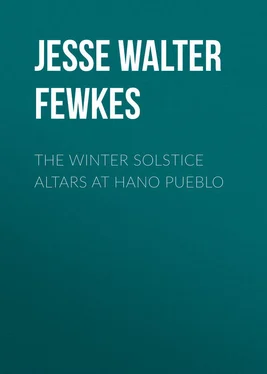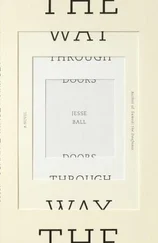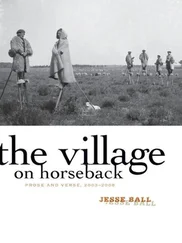Jesse Fewkes - The Winter Solstice Altars at Hano Pueblo
Здесь есть возможность читать онлайн «Jesse Fewkes - The Winter Solstice Altars at Hano Pueblo» — ознакомительный отрывок электронной книги совершенно бесплатно, а после прочтения отрывка купить полную версию. В некоторых случаях можно слушать аудио, скачать через торрент в формате fb2 и присутствует краткое содержание. Жанр: Мифы. Легенды. Эпос, foreign_antique, foreign_prose, на английском языке. Описание произведения, (предисловие) а так же отзывы посетителей доступны на портале библиотеки ЛибКат.
- Название:The Winter Solstice Altars at Hano Pueblo
- Автор:
- Жанр:
- Год:неизвестен
- ISBN:нет данных
- Рейтинг книги:4 / 5. Голосов: 1
-
Избранное:Добавить в избранное
- Отзывы:
-
Ваша оценка:
- 80
- 1
- 2
- 3
- 4
- 5
The Winter Solstice Altars at Hano Pueblo: краткое содержание, описание и аннотация
Предлагаем к чтению аннотацию, описание, краткое содержание или предисловие (зависит от того, что написал сам автор книги «The Winter Solstice Altars at Hano Pueblo»). Если вы не нашли необходимую информацию о книге — напишите в комментариях, мы постараемся отыскать её.
The Winter Solstice Altars at Hano Pueblo — читать онлайн ознакомительный отрывок
Ниже представлен текст книги, разбитый по страницам. Система сохранения места последней прочитанной страницы, позволяет с удобством читать онлайн бесплатно книгу «The Winter Solstice Altars at Hano Pueblo», без необходимости каждый раз заново искать на чём Вы остановились. Поставьте закладку, и сможете в любой момент перейти на страницу, на которой закончили чтение.
Интервал:
Закладка:
Jesse Walter Fewkes
The Winter Solstice Altars at Hano Pueblo
Introduction
The fetishes displayed in their kivas by different phratries during the Winter Solstice ceremony at the Hopi pueblo of Walpi, in northeastern Arizona, have been described in a previous article, 1 1 The Winter Solstice Ceremony at Walpi ( American Anthropologist , vol. XI).
in which the altar made in the Moñkiva , or "chief" ceremonial chamber, by the Patki and related people has been given special attention. The author had hoped in 1898 2 2 These studies were made under the auspices of the Bureau of American Ethnology.
to supplement this description by an exhaustive study of the Winter Solstice ceremonies of all the families of the East Mesa, but was prevented from so doing by the breaking out of an epidemic. This study was begun with fair results, and before withdrawing from the kivas he was able to make a few observations on certain altars at Hano which had escaped him in the preceding year.
Walpi, commonly called by the natives Hopiki , "Hopi pueblo," began its history as a settlement of Snake clans which had united with the Bear phratry. From time to time this settlement grew in size by the addition of the Ala , Pakab , Patki , and other phratries of lesser importance. Among important increments in modern times may be mentioned several clans of Tanoan ancestry, as the Asa , Honani , and the like. These have all been assimilated, having lost their identity as distinct peoples and become an integral part of the population of Walpi, or of its colony, Sitcomovi. 3 3 Most of the people of Sitcomovi are of the Asa and Honani clans, of Tanoan ancestry, but they long ago lost the Tewa language and their Tanoan identity.
Among the most recent arrivals in Tusayan was another group of Tanoan clans which will be considered in this article. The last mentioned are now domiciled in a pueblo of their own called Hano; they have not yet, as the others, lost their language nor been merged into the Hopi people, but still preserve intact many of their ancient customs.
The present relations of Hano to Walpi are in some respects not unlike those which have existed in the past between incoming clans and Walpi as each new colony entered the Tusayan territory. Thus, after the Patki people settled at the pueblo called Pakatcomo, 4 4 The site of this last settlement of the Patki people, before they joined those of Walpi, is in the plain about four miles south of the East Mesa. The ruins of the pueblo are still visible, and the foundation walls can readily be traced.
within sight of Old Walpi, they lived there for some time, observing their own rites and possibly speaking a different language much as the people of Hano do today. In the course of time, however, the population of the Patki pueblo was united with the preëpre Walpi families, Pakatcomo was abandoned, and its speech and ritual merged into those of Walpi. Could we have studied the Patki people when they lived at their former homes, Pakatcomo or Homolobi, we would be able to arrive at more exact ideas of their peculiar rites and altars than is now possible. Hano has never been absorbed by Walpi as the Patki pueblos were, and the altars herein described still preserve their true Tanoan characteristics. These altars are interesting because made in a Tanoan pueblo by Tewa clans which are intrusive in the Hopi country, and are especially instructive because it is held by their priests that like altars are or were made in midwinter rites by their kindred now dwelling along the Rio Grande in New Mexico.
The midwinter rite in which the altars are employed is called Tûñtai by the Tewa, who likewise designate it by the Hopi name Soyaluña . This latter term may be regarded as a general one applied to the assemblages of different families in all the kivas of the East Mesa at that time. The name of the Tewa rite is a special one, and possibly the other families who assemble at this time once had or still retain their own names for their celebrations. The Tûñtai altars were brought by the ancestors of the present people of Hano from their old eastern home, and the rites about them are distinctly Tewan, although celebrated at the same time as the Winter Solstice ceremonies of the Hopi families.
Clan Composition of Hano
The pueblo called Hano is one of three villages on the East Mesa of Tusayan and contained, according to the writer's census of 1893, a population of 163 persons. It was settled between the years 1700 and 1710 by people from Tcewadi, a pueblo situated near Peña Blanca on the Rio Grande in New Mexico. Although only six persons of pure Tanoan ancestry are now living at Hano, the inhabitants still speak the Tewa dialect and claim as kindred the peoples of San Juan, Santa Clara, San Ildefonso, Pojoaque, Nambe, and Tesuque. 5 5 The Hano names of these pueblos are – San Juan, – ; Santa Clara, Kap'a ; San Ildefonso, Pocuñwe ; Pojoaque, P'okwode ; Nambe, Nûme ; Tesuque, Tetsogi . They also claim Taos ( Tawile ) and Picuris ( Ohke ), but say that another speech is mixed with theirs in these pueblos.
The best traditionists declare that their ancestors were invited to leave their old home, Tcewadi, by the Snake chief of Walpi, who was then pueblo chief of that village. They claim that they made their long journey to give aid against the Ute Indians who were raiding the Hopi, and that they responded after four consecutive invitations. The Walpi Snake chief sent them an embassy bearing prayer-sticks as offerings, and although they had refused three invitations they accepted the fourth.
According to traditions the following clans have lived in Hano, but it is not stated that all went to the East Mesa together from Tcewadi: Okuwuñ , Rain-cloud; Sa , Tobacco; Kolon , Corn; Tenyük , Pine; Katcina , Katcina; Nañ , Sand; Kopeeli , Pink Shell; Koyanwi , Turquoise; Kapolo , Crane; Tuñ , Sun; Ke , Bear; Te , Cottonwood; Tayek (?); Pe , Firewood; and Tceta , Bivalve shell.
The early chiefs whose names have been obtained are Mapibi of the Nañ-towa , Potañ of the Ke-towa , and Talekweñ and Kepo of the Kolon-towa . The present village chief is Anote of the Sa-towa or Tobacco clan. 6 6 The Tewa of Hano call the Hopi Koso , and the Hopi speak of the Hano people as the Towa or the Hanum-nyûmû . The word "Moki," so constantly used by white people to designate the Hopi, is never applied by the Hopi to themselves, and they strongly object to it. The dead are said to be moki , which enters into the formation of verbs, as tconmoki , to starve; tcinmoki , to be very lonesome, etc. The name Hano or Hanoki is, I believe, simply a combination of the words Hano and ki , "eastern pueblo." The element hano appears also in the designation for American, Pahano , "eastern water"; pahanoki , "American house." Both the Asa and the Tewa peoples are called Hanum clans.
Of the original clans which at some time have been with the Hano people, the following have now become extinct: Kopeeli , Koyanwi , Kapolo , Tuñ , Tayek , Pe , 7 7 Remains of old reservoirs, elaborately walled, from which water was drawn by means of a gourd tied to a long pole, are still pointed out near Tukinovi and are said to have belonged to the Pe-towa . Old Tcasra claims that they were in use in his mother's grandmother's time.
and Tceta . The last member of the Tuñ or Sun people was old chief Kalacai who died about four years ago. It is quite probable that several of these extinct clans did not start from Tcewadi with the others. There were several waves of Tanoan emigrants from the Rio Grande region which went to Tusayan about the same time, among which may be mentioned the Asa , which took a more southerly route, via Zuñi. The route of the Asa people will be considered in another article, and the evidences that some of the Asa clans joined their kindred on their advent into Tusayan will be developed later. Probably certain members of the Katcina clan accompanied the Asa people as far as the Awatobi mesa and then affiliated with the early Hano clans. 8 8 The troubles following the great rebellion of 1680 drove many Tewa from the Rio Grande valley to Tusayan.
Интервал:
Закладка:
Похожие книги на «The Winter Solstice Altars at Hano Pueblo»
Представляем Вашему вниманию похожие книги на «The Winter Solstice Altars at Hano Pueblo» списком для выбора. Мы отобрали схожую по названию и смыслу литературу в надежде предоставить читателям больше вариантов отыскать новые, интересные, ещё непрочитанные произведения.
Обсуждение, отзывы о книге «The Winter Solstice Altars at Hano Pueblo» и просто собственные мнения читателей. Оставьте ваши комментарии, напишите, что Вы думаете о произведении, его смысле или главных героях. Укажите что конкретно понравилось, а что нет, и почему Вы так считаете.











